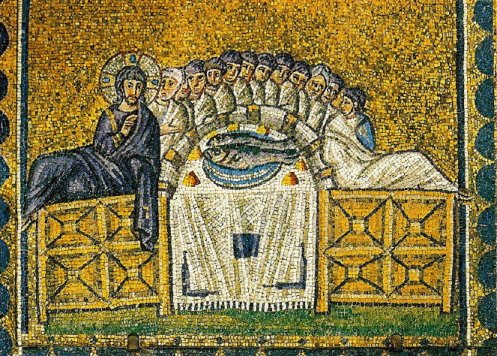|
Sant'Apollinaire
Nuovo |
I included this image when writing about the Last Supper in the section on the Passion. Reading up on the present topic has made me wonder if I should have done so. |
|
|
| The problem comes down to -
who said anything about fish? In my Last Supper section (in The Passion and Resurrection of Christ) I suggested that the absence of Eucharistic symbols could identify the image as Arian. But is it that simple? Even putting aside the obvious point that if it were so it would probably have been removed, there are issues that my more recent reading has identified. In particular, I've read again Robin Margaret Jensen's Understanding Early Christian Art, and a paper by Dragos Mirsanu, Further notes on the Aesthetic 'Shadow' of Gothic Arianism in Ravenna. Mirsanu quotes Ballarmino Bagatti (Il significato della cena nel mosaic di Sa. Apollinaire in Ravenna) who suggests that the scene is 'a likely depiction of a distinctive liturgical practice of the Gothic Arians, who might have continued the observance of an agape equivalent to the formal supper of the Jewish Cena pura, as they believed that the Last Supper was actually such a religious meal'. Maybe so: undoubtedly the Last Supper is suggested - count the disciples - all twelve! (One isn't that easy to spot.) There was, it seems, a tradition of a group of Jewish friends, known as chaburah, who met for a meal on the eve of holy days, often, of course, Fridays. Thus, no lamb - fish instead, a continuing tradition for Friday and entirely suitable for the apostles, many of whom were fisherman. Such an image would therefore, it is argued, not be a powerful symbol of the divinity of Christ. It would, however, follow the Chronology of John's Gospel, which tells us that the Last Supper was not a Passover meal at all, but one eaten 24 hours before. Robin Margaret Jensen takes a slightly different line. She compares the image to those of agape meals found in Christian catacombs, which frequently include fish. Could they could be images of the Last Supper in disguise? A problem arises; the is no specific biblical reference to fish being eaten at the meal. But Jensen wonders if, by the fifth century, fish had become a standard element of the iconography of the scene. The fish was an important early symbol of Christ, and thus asking the Apostles to eat the fish could be interpreted as Eucharistic. Jensen has much more to say, and her book is thoroughly recommended. |
